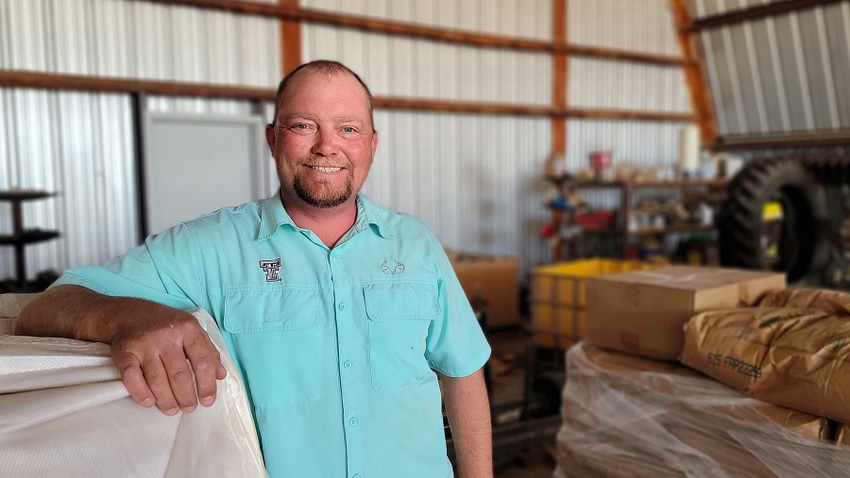
When it comes to organic and conventional peanut production, John Reddecop takes a double-barreled approach: rest and test. Rest the land for at least a year and test products and varieties before they’re applied or planted. The result? Increased yields coupled with improved quality and this year, recognition as one of four Farm Press Peanut Efficiency Award winners.
Annually, Farm Press recognizes producers throughout the Peanut Belt who use regenerative practices to achieve high yields and grades. Reddecop is the Southwest winner. The winner for the Lower Southeast is Ryan Jenkins; Colt Woody and Brandon Woody for the Upper Southeast; and Tripple D Farms (Bill, Mark, Clay, Matt and Hunter Deane) in the Delta.
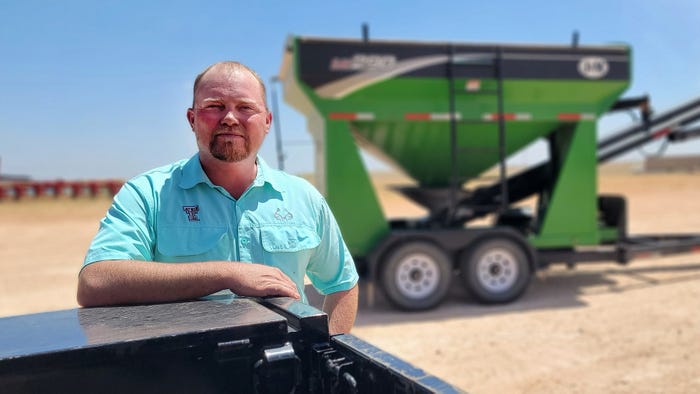
John Reddecop grows organic and conventional peanuts and cotton, and rye in Yoakum County, Texas. (Photo by Shelley E. Huguley)
“I’ve found out my yields go through the roof leaving my land out of production at least one year,” said Reddecop, who farms in Yoakum County, Texas. “That’s where my biggest yields come from.”
In 2022, Reddecop grew Virginia-type varieties. His Emerys yielded 5,600 pounds per acre pay weight and the Wynnes yielded 7,035 pounds – a career-best. “That was the second year in a row,” Reddecop said, adding that in 2021, his yields hit 7,000 pounds on that same section.
Resting his land also beneficial because he’s not having to irrigate. “You're not watering it constantly putting the high mineral water we have through your pivots. You do get a few rains, but your pH is a lot better. When you leave it in (rye) stubble, if it does rain, it keeps the water right here.
“It's like we're refueling it. It's like a tank. It keeps the moisture.”
Test plots are key. “We have test plots every year, either on fertilizer or different varieties of peanuts and cotton,” said Reddecop, who farms with his brother Henry. The plots are not company-sponsored. They are instigated by the brothers’ curiosity.
This year, the Reddecops are testing a theory from growers in the Eastern U.S. that peanuts don’t require heavy fertilization. “On this field, I have two separate fertilizers I’m testing and then I’ve got a pass in between them with zero fertilizer,” John said.
One fertilizer is a blend he’s used the last two years -- 15-16-19-5. The other is the same but includes Helena’s Hydro Hume. “And the strip down the center has nothing. Later this year, when I come in with urea, the whole field is going to get about 200 pounds of urea except for that one pass. It’s going to get nothing and that’s going to determine how much fertilizer benefits you, especially on peanuts.”
Cover crop
John describes the soil in his region as some of the best in world, but there’s a catch. He has to keep it from blowing. John’s number one defense is planting a heavy rye cover crop. “There is very little of my land that blows,” he said. “It ruins a farm if it blows.”
Prior to digging and just ahead of the diggers, the Reddecops spread 100 pounds of rye per acre. “And if we have a wet year, we harvest in green fields. We get cold nights, so the sooner you can get your rye in the better, especially in the peanut field, because by the time you're done it is bare.”
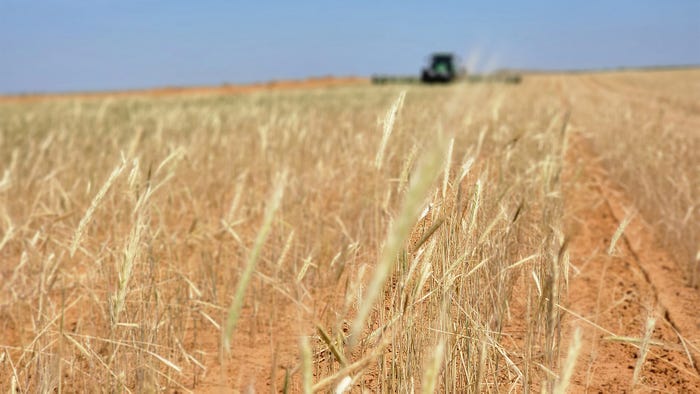
Planting the 2023 peanut crop into rye cover. (Photo by Shelley E. Huguley)
Getting a good cover up before a freeze is crucial, he said. John plants rye on acres he’s transitioning from conventional to organic, a process he began in 2015. Conventional acres must “rest” for three years before organic peanuts or cotton can be planted.
“Not being able to plant anything besides rye, you don’t get any income, so it’s hard transitioning but that’s why I do the rye,” he said.
What rye he doesn’t keep to plant the next year, he sells to neighbors. “So, there’s a little bit of money in it, just not what the peanuts can do.”
And even though rye is growing, the land is still considered rested. Plus, “you’re not watering it constantly putting the high mineral water that we have through your pivots. You do get a few rains,” John says. “It’s
Looking back
John began farming at 15 with his uncle. In 2014, the region’s diminishing irrigation water caused his uncle to get out and turn over the operation to him and Henry. But it wouldn’t be easy.
Within that first year, John, 27 at the time, would also become a new father to a “colicky baby” and their peanut buyer, Clint Williams, would file bankruptcy, leaving John with a 6,000-pound bumper crop, and stress-induced hives that eventually required hospitalization. “It was a rough year,” he said.
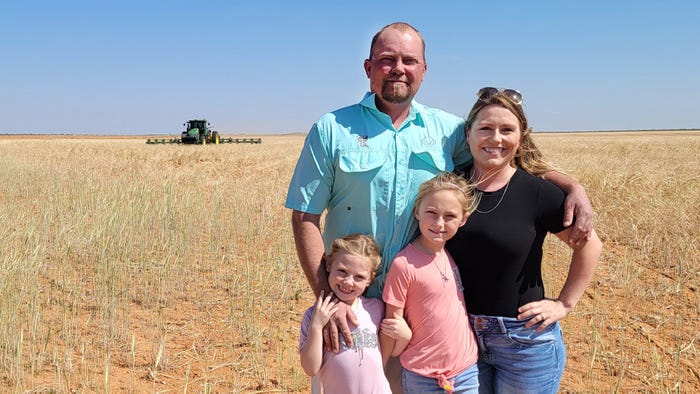
John Reddecop family, from left, John with wife Lena and their daughters Mia and Gracie. (Photo by Shelley E. Huguley)
The Reddecops didn’t give up. Lena, John’s wife, credits God for surviving that initial year. “We couldn’t have gotten through it by ourselves,” she said.
It was 2017 before John grew peanuts again and their first organic peanut crop, which yielded 3,600 pounds. “2018 was my worst yielding year, across the board, both organic and conventional,” John admitted. But as we say in farming, “wait a year.” 2019 proved to be a personal best for his organic acres, yielding 4,400 pounds.
Water
Diminishing irrigation water, often combined with drought, remains an issue. Since 2014, the wells on each section have dropped about 250 gallons per section, forcing the Reddecops to push their water to a 160-acre circle, leaving the remaining 480 acres on the section fallow or dryland. “On average, of the water here, my water-to-land ratio is a half-gallon an acre of irrigation to land,” John said.
Because organic peanuts contract for more than double the conventional, the Reddecops can cut acreage and therefore water demand without losing profit. “For instance, the Spanish peanuts I'm planting this year, I have a $700-contract on conventional versus my organics are at $1,550, so I can afford to make less yield on smaller acreage and my gross net is higher.”
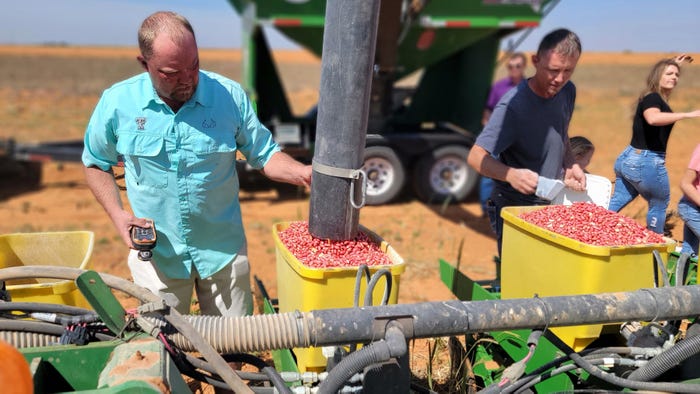
Brothers and farming partners John and Henry Reddecop load the planter. (Photo by Shelley E. Huguley)
When selecting farms for organic production, John is careful to convert land with few grass problems. “As soon as you get grass issues, there's nothing you can do on organic. Your field is done. My plan was to turn this into organic, but then I realized I have nut grass on the other half, and some kind of lakeweed grass on this side. I need a few more years to see if I can clean up the grass first.”
Farming in a “desert area” like West Texas, John said, “We have a lot less insect pressure than most anybody else in the country, so we can grow organic peanuts and cotton, I think, better than anybody else.”
Organic disease, though, is a tossup. “I have not figured out disease, as far as organic. One bad thing and a good thing about organic is after you've planted, you know within three weeks what kind of crop you are going to make depending on your stand.”
Germination is low. “You start off with a skippy stand in the beginning and then it’s up to you how much money you want to stick into it throughout the year. My most expensive hoeing bill that I've had has been $400 an acre (2018). That’s just hoeing. That’s not the seed price or the compost or the lease. So organic, you can benefit from it, but you can also lose quickly.”
Ideally, the best scenario is to convert CRP land to organic, John said. “Then you're good for a few years. You have no diseases, and your yields are going to be through the roof. I'm transitioning old farm dirt into organic, so my yield is not where everybody else’s is. My weed pressure is higher. So, it does come with consequences.”
The Reddecops deliver both their organic and conventional peanuts about 30 miles away to Trico Peanut Company in Seminole, Texas, where they are shelled and sold. Some are roasted and packaged at the company’s in-house roasting plant, Texas Roasting Company.
Family farm
When John considers his production success, he doesn’t only credit management practices. He points to Lena for helping him make decisions. “She keeps me sane,” he said.
On the farm, though “100% opposites,” he credits his partnership with Henry. “I’m more the pusher, so I’ll get a lot of things done, but he’ll do it better.”

Henry Reddecop, left, works with farm manager Cornelius Wheeler, on preparing seed for a field trial. (Photo by Shelley E. Huguley)
Henry is the only one who sprays. “Everything he does, I can trust 100%,” John said. “Everything is to-the-tee precise. He’s a perfectionist and I’m more of the go-getter, the brunt, the workforce.”
Originally, when their uncle quit farming, Henry just wanted to spray for John and John’s brother-in-law. “I told him I didn’t want to farm without him, so I forced him into farming,” John said laughing. “I’m glad I did. I wouldn’t want to farm all this without him.”
Read more about:
Peanut Efficiency AwardAbout the Author(s)
You May Also Like






